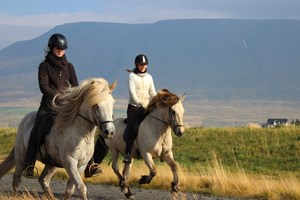THE ICELANDIC HORSE IN CULTURE
The Icelandic horse has always played a big role in the Icelandic life and culture. Previously he was used for travelling, transportation and other work, Icelanders used to call him the most useful servant or Þarfasti Þjónninn. The horse was the only transport in Iceland back in the days and it would have been hard to live without him. In the 1900s Icelanders began to use horse carriage and the horses were used for pulling them. After the World War II tractors came to Iceland so the use of the horse was not as important. Around the same time the first car came to Iceland so there was also less need for the horse in transportation. Then people began to breed him as a riding horse, and he became a major part of people’s hobby in Iceland. Today the Icelandic horse is one of the most popular and versatile riding horses in the world and he is the best ambassador of our little country around the world.
HOW IS THE ICELANDIC HORSE?
The horses grew up in the Icelandic nature, so they had to fight through all kinds of weather conditions making them adapt the Icelandic climate, which can be harsh and unpredictable, with a thick double-layered winter coat and their ability to store fat that they accumulate during the summer and that serves as an insulator and source of energy during winter. The nature and weather have thus shaped the character of the horse as it is today.
The character of the Icelandic horse is friendly and welcoming, they are adventurous, intelligent and quick to learn. They are easy to operate and cooperative, but they can also be powerful and willing to work.
Horses know how to adapt to each task that is given to them, knowing when it is time for full power or to tune down, that is why they are versatile animals that can be an excellent horse for the family or for high-level competitions, this quality is highly prized among Icelandic horse lovers and is a very important breeding goal.
Horse breeds are usually divided into two categories, horses and small horses or ponies, it depends on their size, temperament, and qualities. The average height of the Icelandic horse is between 132-147 cm which is usually considered a pony size. But his character and qualities make up for his size, so he is usually not called a pony, at least Icelanders don’t like to call him that.
GAITS
Compared to other horse breeds the Icelandic horse is considered to have good qualities, he has good temperament and a large personality. He is a small horse, but he is very strong and has great endurance. He is usually very willing, soft in movements and comfortable to ride. Most horse breeds have three gaits, but the Icelandic horse has five. The typical gaits are walk, trot and canter/gallop in addition to that the Icelandic horse can also perform a four-beat lateral ambling gait known in Icelandic as Tölt and other one is pace or Skeið in Icelandic. Unlike other horse breeds the Icelandic horse comes in many colors, including black, gray, chestnut, dun, palomino and pinto. In the Icelandic language there are over 100 names for various colors and color patterns.
WHERE TO SEE ICELANDIC HORSES?
Let's take into account some guidelines to be in contact with Icelandic horses. You can see them throughout the country, but it is important not to cross the fences and gates and enter private property, and above all not to feed the horses without the permission of their owners, since inadvertently we could be harming the horse, or creating unwanted behaviors in horses that would wreck the hard work of owners and trainers.
You can be in contact with this gentle friends, keeping them healthy and in the right way in one of the horse riding tours that you will find throughout the country.

















